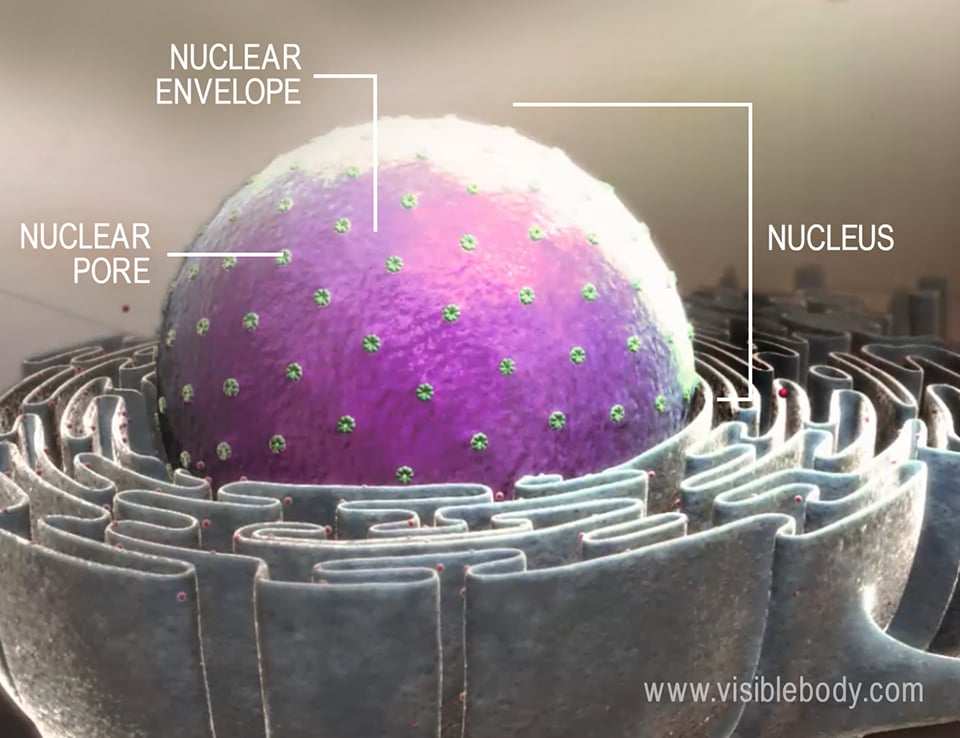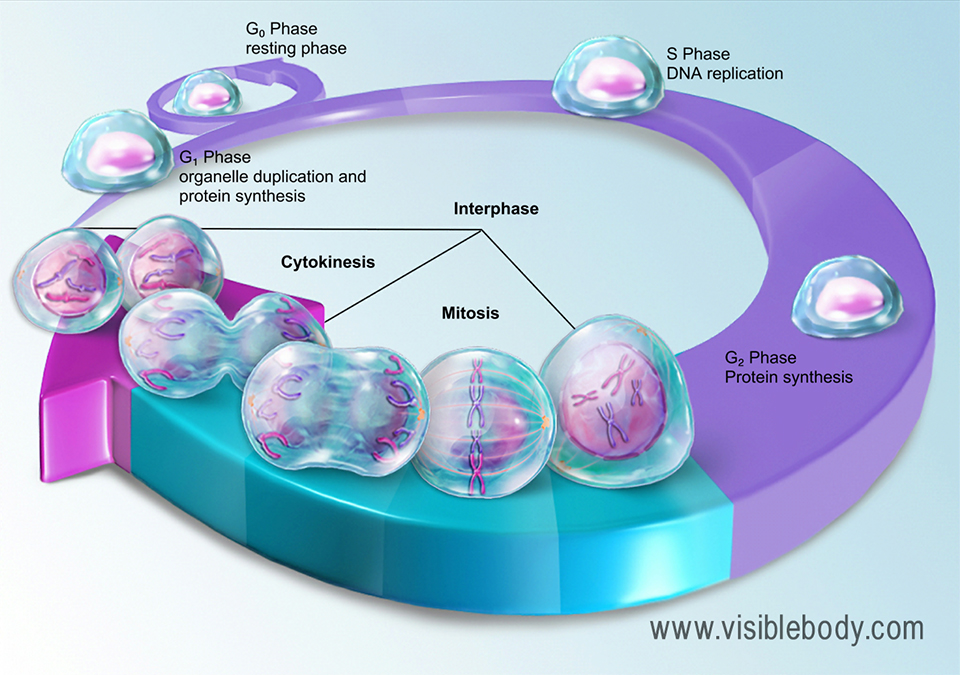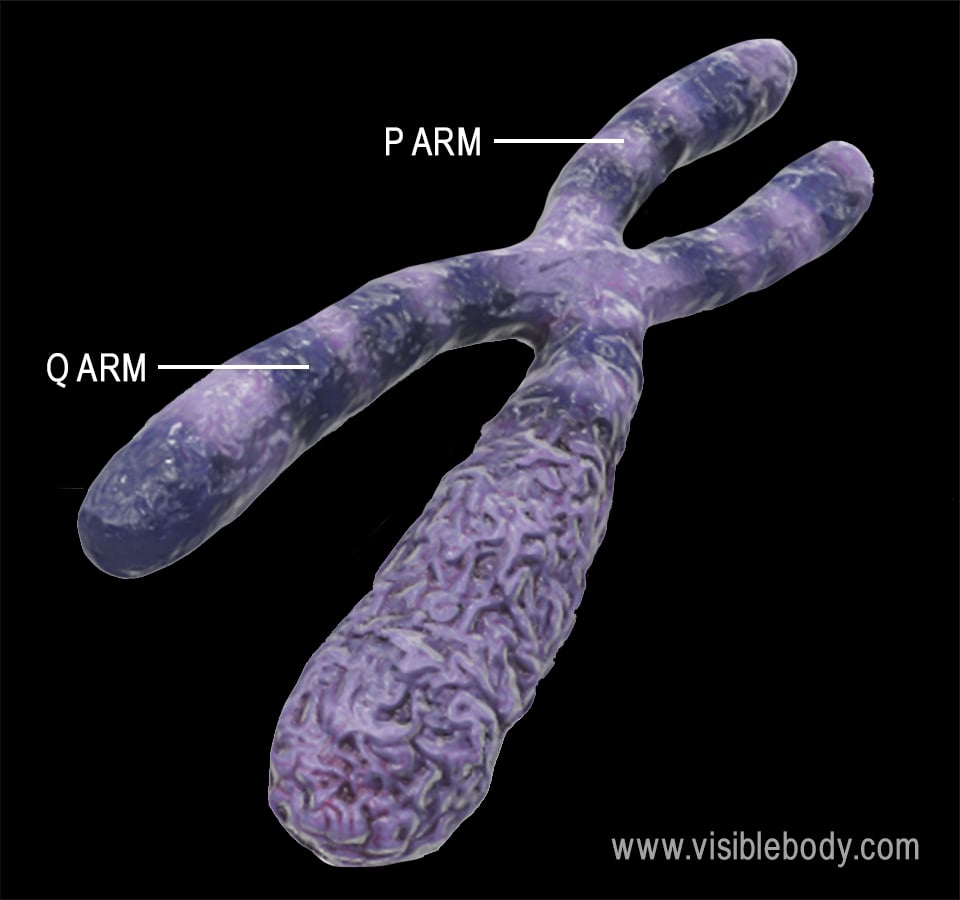Eukaryotic Chromosomes Are Composed Of
Eukaryotic Chromosome Structure
1. Eukaryotic chromosomes are establish in the cell's nucleus.
The principal characteristic that distinguishes a eukaryotic cell from a prokaryotic cell is the presence of a membrane-bound nucleus. This nucleus is the "command center" of the jail cell that stores all the jail cell'due south genetic information, or DNA. The nuclear membrane, or nuclear envelope, contains channels chosen pores that regulate the motility of molecules in and out of the nucleus.

The Deoxyribonucleic acid inside the nucleus is organized into chromosomes. At the almost bones level, a chromosome is a molecule of Dna that is tightly coiled around proteins chosen histones. Eukaryotic cells accept multiple chromosomes that are linear in shape.
ii. Each chromosome contains a molecule of Dna that is wound tightly around clusters of histone proteins.
Individual DNA molecules are extremely long, consisting of millions of base pairs (matched nucleotides) each. How do cells store such large and potentially unwieldy molecules? Much like you'd store yarn or thread—wound onto a spool—DNA is compacted, coiled, and folded into a meaty shape.
Chromatin consists of all the Deoxyribonucleic acid in the nucleus, likewise as its associated proteins. At that place are three bones layers of chromatin scaffolding that results in a condensed DNA molecule.
The double helix shaped DNA molecule that makes up each chromosome is outset coiled around clusters of histone proteins. A unit of around 200 Dna base pairs wound around 8 histone proteins makes up the smallest unit of measurement of DNA-packing structure, a nucleosome.
The nucleosomes and the linker DNA that connects them, like beads on a string, loop to form more tightly-packed thirty-nm solenoid fibers. Then, the xxx-nm fibers are coiled farther and folded into loops that are tightly packed together. This last phase of scaffolding produces the chromosomes observable in metaphase of mitosis or meiosis.
The process that creates the 30nm fibers is called supercoiling. Supercoiling uses the application of tension to twist a Dna molecule, so information technology wraps around itself, creating loops.
Even with a microscope, individual chromosomes are clearly visible in the nucleus merely during the process of jail cell division (either mitosis or meiosis). This is because the chromatin that makes up the chromosomes is hundreds, or fifty-fifty thousands, of times less condensed during interphase than it is when the cell is actively dividing.
3. Before a eukaryotic cell divides, each chromosome duplicates, forming two identical sister chromatids joined together lengthwise with their strongest connection at the centromere.
Before mitosis begins, a cell'due south Dna replicates itself, making an identical copy of each chromosome.

It is during mitosis or meiosis that the 10-shaped structures nosotros ordinarily picture when thinking of chromosomes can be observed.
Each of these X-shaped chromosomes consists of two identical sister chromatids. Basically, yous can retrieve of a chromatid as one copy of a chromosome.
The sister chromatids are continued to each other by a region of the chromosome chosen the centromere. During mitosis, spindle fibers attach to this region, and they eventually pull the sister chromatids apart to form two separate chromosomes, one for each daughter cell.
The centromere as well divides each chromatid into two regions: the p arm and the q arm. The p arm is the shorter arm, and the q arm is the longer arm. When geneticists describe the location of a cistron on a chromosome, they will specify the number of the chromosome (i-22, 10, and Y for humans), the arm (p or q), and the cistron's location on the arm.

four. The somatic cells of sexually-reproducing eukaryotic organisms are diploid, meaning that they have two sets of homologous chromosomes.
The somatic cells of the human trunk—that is, the cells that aren't gametes, or sex cells—each have 46 chromosomes. They are diploid cells, which means that those 46 chromosomes are organized into 23 pairs. Diploid is sometimes abbreviated as 2n (where north is the number of different chromosomes).
In humans, 22 out of the 23 chromosome pairs are autosomes, or non-sexual activity chromosomes. These are referred to as homologous pairs because the 2 chromosomes within the pair are the same size and shape and incorporate the same genes (with potentially unlike alleles, which are alternating versions of a factor). The 23rd pair is made upwards of the sex chromosomes. Typically, people who are biologically male have an XY genotype (an X chromosome and a Y chromosome), and people who are biologically female have an Xx genotype (two X chromosomes). The Twenty pair, just non the XY pair, is considered to be a homologous pair.
The sex cells, or gametes, of sexually-reproducing eukaryotic organisms are haploid (1n), meaning they merely accept 23 unpaired chromosomes. When a sperm cell fertilizes an egg, the resulting zygote is diploid; the combination of the 2 haploid sex cells is what results in the zygote having the full 46 chromosomes. One chromosome in each pair comes from the mother's egg cell, and the other comes from the father'south sperm prison cell.
5. Telomeres protect the ends of chromosomes, and they get shorter every time a jail cell divides.
Telomeres are special regions, located on each end of the chromosome, that consist of repetitive sequences of base of operations pairs. They are typically described as being like the plastic caps on the ends of shoelaces. This is considering they protect the ends of chromosomes and keep them from sticking to other chromosomes.
Nevertheless, the most of import function of telomeres is that they allow cells to divide without losing their genetic material. If in that location were no telomeres, some base of operations pairs would exist lost every time DNA replication takes place. Fortunately, it is the telomeres, and not the genes, that get shorter with every cell partition. For example, the telomeres in homo cells generally lose betwixt 30 and 200 base pairs every time a cell divides.
Normally, a cell in the human body can carve up effectually 50-lxx times before it becomes senescent (inactive, no longer dividing) or dies. Every bit humans age, the telomeres on the ends of the chromosomes gradually become shorter.
A special enzyme called telomerase adds telomeres to the ends of replicated chromosomes, significant that cells with an increased level of this enzyme—like sperm and egg cells, or certain cancer cells—can split up more frequently.
half-dozen. Eukaryotic and prokaryotic chromosomes differ in their shape, size, number, and location inside the cell.
Here's how the characteristics of eukaryotic chromosomes compare to those of prokaryotic chromosomes:
| Eukaryotic Chromosome | Prokaryotic Chromosome | |
|---|---|---|
| Shape | Linear | Round |
| Size | Large | Modest |
| Number | Multiple | Single |
| Location | Nucleus | Nucleoid (region in cytoplasm) |
| Storage proteins | Histones | Nucleoid-associated proteins |
Eukaryotic Chromosomes Are Composed Of,
Source: https://www.visiblebody.com/learn/biology/dna-chromosomes/eukaryotic-chromosomes
Posted by: mcintyrerowend.blogspot.com


0 Response to "Eukaryotic Chromosomes Are Composed Of"
Post a Comment